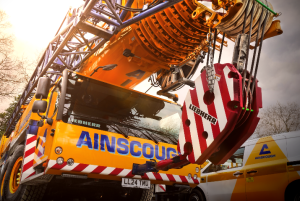Ground breaking material is leading the way forward

It has been hailed as the ‘wonder material’ set to revolutionise the way we live and work. Graphene was first isolated at The University of Manchester and the city continues to lead the way when it comes to its research and development.
Described as the world’s first 2D material, graphene is ultra-light, yet immensely tough. And while it is 200 times stronger than steel, it is also incredibly flexible.
The challenge to industry is harnessing this “super hero” material commercially – to take it out of the research lab and into the real world.
Opened last year, the £60m Graphene Engineering Innovation Centre (GEIC) in Manchester is looking to do just that. It specialises in the rapid development and scale up of graphene and other 2D materials applications.
Nic Gowland, GEIC business development manager, says the aim is to bridge the gap between academic research and industry.
The GEIC has been designed to work in collaboration with industry partners to create, test and optimise new concepts for delivery to market, along with the processes required for scale up and supply chain integration.
Gowland says “speed is the key”. The centre has its own team of engineers and scientists with industry experience who can react as quickly as required.
As well as moving quicker than traditionally the case when it comes to industry and university collaboration, the GEIC also looks to cut the financial cost to businesses.
It can work on short feasibility projects, through to a long-term strategic partnership with multiple projects in different application areas.
Gowland says industry “loves” this new approach. He adds that graphene is being used in a growing number of commercial applications and he expects that to continue.
He cites last year’s launch of the world’s first-ever sports shoes to use graphene by British brand inov-8.
The work goes on. A team of researchers at the University of Manchester has just developed a method to produce scalable graphene-based yarn.
Multi-functional wearable e-textiles have been a focus of much attention because of their great potential for use in healthcare, sportswear, fitness and aerospace.
Graphene has been considered a potentially good material for these types of applications because of its high conductivity and flexibility.
Researchers say the ultra-fast production process for graphene-based textiles being developed in Manchester is an important step towards realising next generation high performance clothing.
Meanwhile, research at the University of Central Lancashire (UCLan) is helping define the way graphene can be used to revolutionise the aerospace industry.
UCLan scientists and researchers are concentrating their efforts on the use of the revolutionary “super-hero” material in aerospace and satellite technology.
To that end they created Juno, the world’s first graphene skinned plane, which made global headlines when unveiled at the internationally-renowned Farnborough Air Show last year.
And in another high-flying project, they are exploring the practical applications of exploiting graphene to boost the UK’s space industry.
This initiative is being achieved through the launch of specially designed graphene-enhanced carbon fibre material into near space using high altitude balloons.
The UCLan team believes that graphene, in combination with other materials, could allow satellites to be lighter, reducing the costs of launching them into space and making them more robust against the impacts of space debris.
The Preston-based university’s endeavours have been rewarded, with UCLan named as a GEIC ‘foundation partner’.
Prof Darren Ansell, the aerospace engineering lead at UCLan, says much of its work is looking at ways to incorporate graphene into the build structure of aeroplanes to reduce weight and increase impact strength.
The findings so far have been encouraging, and he says: “By working collaboratively with our partners and industry leaders, we are looking forward to discovering more in the future.”
The research is also looking to showcase the effects of graphene in drag reduction, thermal management and ultimately the ability to achieve lightning strike protection for aircraft.
Prof Ansell says the university is making “great strides” in leading a programme to accelerate the uptake of graphene and other nano-materials into the aerospace sector.
He adds: “Ultimately the aim is to get this into industry. Part of our role is to help to de-risk these new technologies for companies.
“And we are working not only with the major players but also throughout the supply chain. This could be game changing for smaller companies and that is why collaboration is vital.”
UCLan’s work exploring the practical applications of exploiting graphene in the UK space industry has been part-funded by the UK Space Agency’s National Space Technology Programme.
The balloons launched as part of this project have gone as high as 124,000ft, which is more than four times the height reached by an average aeroplane.
By comparing a graphene-enhanced carbon fibre to a standard carbon fibre casing, researchers are able to test how both react to extreme conditions high above the earth. They can then compare the results to determine how graphene can be utilised in space.
Prof Ansell says: “We have taken graphene to new heights, looking at how it could potentially form an integral component of future satellites and space vehicles.
“The potential application of graphene continues to amaze us. We’re learning all the time.”








